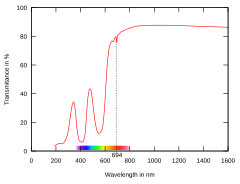Inoptical physics,transmittanceof the surface of a material is its effectiveness in transmittingradiant energy.It is the fraction of incident electromagneticpowerthat is transmitted through a sample, in contrast to thetransmission coefficient,which is the ratio of the transmitted to incidentelectric field.[2]


Internal transmittancerefers to energy loss byabsorption,whereas (total) transmittance is that due to absorption,scattering,reflection,etc.
Mathematical definitions
editHemispherical transmittance
editHemispherical transmittanceof a surface, denotedT,is defined as[3]
where
- Φetis theradiant fluxtransmittedby that surface;
- Φeiis the radiant flux received by that surface.
Spectral hemispherical transmittance
editSpectral hemispherical transmittance in frequencyandspectral hemispherical transmittance in wavelengthof a surface, denotedTνandTλrespectively, are defined as[3]
where
- Φe,νtis thespectral radiant flux in frequencytransmittedby that surface;
- Φe,νiis the spectral radiant flux in frequency received by that surface;
- Φe,λtis thespectral radiant flux in wavelengthtransmittedby that surface;
- Φe,λiis the spectral radiant flux in wavelength received by that surface.
Directional transmittance
editDirectional transmittanceof a surface, denotedTΩ,is defined as[3]
where
- Le,Ωtis theradiancetransmittedby that surface;
- Le,Ωiis the radiance received by that surface.
Spectral directional transmittance
editSpectral directional transmittance in frequencyandspectral directional transmittance in wavelengthof a surface, denotedTν,ΩandTλ,Ωrespectively, are defined as[3]
where
- Le,Ω,νtis thespectral radiance in frequencytransmittedby that surface;
- Le,Ω,νiis the spectral radiance received by that surface;
- Le,Ω,λtis thespectral radiance in wavelengthtransmittedby that surface;
- Le,Ω,λiis the spectral radiance in wavelength received by that surface.
Luminous transmittance
editIn the field ofphotometry (optics),the luminous transmittance of a filter is a measure of the amount of luminous flux or intensity transmitted by an optical filter. It is generally defined in terms of astandard illuminant(e.g. Illuminant A, Iluminant C, or Illuminant E). The luminous transmittance with respect to the standard illuminant is defined as:
where:
- is the spectral radiant flux or intensity of the standard illuminant (unspecified magnitude).
- is the spectral transmittance of the filter
- is theluminous efficiency function
The luminous transmittance is independent of the magnitude of the flux or intensity of the standard illuminant used to measure it, and is a dimensionless quantity.
Beer–Lambert law
editBy definition, internal transmittance is related tooptical depthand toabsorbanceas
where
- τis the optical depth;
- Ais the absorbance.
TheBeer–Lambert lawstates that, forNattenuating species in the material sample,
or equivalently that
where
- σiis theattenuation cross sectionof the attenuating speciesiin the material sample;
- niis thenumber densityof the attenuating speciesiin the material sample;
- εiis themolar attenuation coefficientof the attenuating speciesiin the material sample;
- ciis theamount concentrationof the attenuating speciesiin the material sample;
- ℓis the path length of the beam of light through the material sample.
Attenuation cross section and molar attenuation coefficient are related by
and number density and amount concentration by
where NAis theAvogadro constant.
In case ofuniformattenuation, these relations become[4]
or equivalently
Cases ofnon-uniformattenuation occur inatmospheric scienceapplications andradiation shieldingtheory for instance.
Other radiometric coefficients
edit| Quantity | SI units | Notes | |
|---|---|---|---|
| Name | Sym. | ||
| Hemispherical emissivity | ε | — | Radiant exitance of asurface,divided by that of ablack bodyat the same temperature as that surface. |
| Spectral hemispherical emissivity | εν ελ |
— | Spectral exitance of asurface,divided by that of ablack bodyat the same temperature as that surface. |
| Directional emissivity | εΩ | — | Radianceemittedby asurface,divided by that emitted by ablack bodyat the same temperature as that surface. |
| Spectral directional emissivity | εΩ,ν εΩ,λ |
— | Spectral radianceemittedby asurface,divided by that of ablack bodyat the same temperature as that surface. |
| Hemispherical absorptance | A | — | Radiant fluxabsorbedby asurface,divided by that received by that surface. This should not be confused with "absorbance". |
| Spectral hemispherical absorptance | Aν Aλ |
— | Spectral fluxabsorbedby asurface,divided by that received by that surface. This should not be confused with "spectral absorbance". |
| Directional absorptance | AΩ | — | Radianceabsorbedby asurface,divided by the radiance incident onto that surface. This should not be confused with "absorbance". |
| Spectral directional absorptance | AΩ,ν AΩ,λ |
— | Spectral radianceabsorbedby asurface,divided by the spectral radiance incident onto that surface. This should not be confused with "spectral absorbance". |
| Hemispherical reflectance | R | — | Radiant fluxreflectedby asurface,divided by that received by that surface. |
| Spectral hemispherical reflectance | Rν Rλ |
— | Spectral fluxreflectedby asurface,divided by that received by that surface. |
| Directional reflectance | RΩ | — | Radiancereflectedby asurface,divided by that received by that surface. |
| Spectral directional reflectance | RΩ,ν RΩ,λ |
— | Spectral radiancereflectedby asurface,divided by that received by that surface. |
| Hemispherical transmittance | T | — | Radiant fluxtransmittedby asurface,divided by that received by that surface. |
| Spectral hemispherical transmittance | Tν Tλ |
— | Spectral fluxtransmittedby asurface,divided by that received by that surface. |
| Directional transmittance | TΩ | — | Radiancetransmittedby asurface,divided by that received by that surface. |
| Spectral directional transmittance | TΩ,ν TΩ,λ |
— | Spectral radiancetransmittedby asurface,divided by that received by that surface. |
| Hemispherical attenuation coefficient | μ | m−1 | Radiant fluxabsorbedandscatteredby avolumeper unit length, divided by that received by that volume. |
| Spectral hemispherical attenuation coefficient | μν μλ |
m−1 | Spectral radiant fluxabsorbedandscatteredby avolumeper unit length, divided by that received by that volume. |
| Directional attenuation coefficient | μΩ | m−1 | Radianceabsorbedandscatteredby avolumeper unit length, divided by that received by that volume. |
| Spectral directional attenuation coefficient | μΩ,ν μΩ,λ |
m−1 | Spectral radianceabsorbedandscatteredby avolumeper unit length, divided by that received by that volume. |
See also
editReferences
edit- ^"Electronic warfare and radar systems engineering handbook".Archived from the original on September 13, 2001.
{{cite web}}:CS1 maint: unfit URL (link) - ^IUPAC,Compendium of Chemical Terminology,2nd ed. (the "Gold Book" ) (1997). Online corrected version: (2006–) "Transmittance".doi:10.1351/goldbook.T06484
- ^abcd"Thermal insulation — Heat transfer by radiation — Physical quantities and definitions".ISO 9288:1989.ISOcatalogue. 1989.Retrieved2015-03-15.
- ^IUPAC,Compendium of Chemical Terminology,2nd ed. (the "Gold Book" ) (1997). Online corrected version: (2006–) "Beer–Lambert law".doi:10.1351/goldbook.B00626